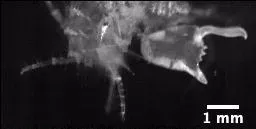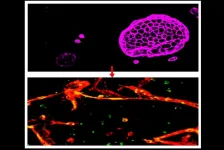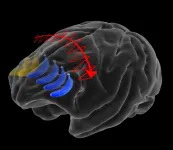Brain changed by caffeine in utero, study finds
New research finds caffeine consumed during pregnancy can change important brain pathways in baby
2021-02-08
(Press-News.org) New research finds caffeine consumed during pregnancy can change important brain pathways that could lead to behavioral problems later in life. Researchers in the Del Monte Institute for Neuroscience at the University of Rochester Medical Center (URMC) analyzed thousands of brain scans of nine and ten-year-olds, and revealed changes in the brain structure in children who were exposed to caffeine in utero.
"These are sort of small effects and it's not causing horrendous psychiatric conditions, but it is causing minimal but noticeable behavioral issues that should make us consider long term effects of caffeine intake during pregnancy," said John Foxe, Ph.D., director of the Del Monte Institute for Neuroscience, and principal investigator of the Adolescent Brain Cognitive Development or ABCD Study at the University of Rochester. "I suppose the outcome of this study will be a recommendation that any caffeine during pregnancy is probably not such a good idea."
Elevated behavioral issues, attention difficulties, and hyperactivity are all symptoms that researchers observed in these children. "What makes this unique is that we have a biological pathway that looks different when you consume caffeine through pregnancy," said Zachary Christensen, a M.D/Ph.D. candidate in the Medical Science Training Program and first author on the paper published in the journal Neuropharmacology. "Previous studies have shown that children perform differently on IQ tests, or they have different psychopathology, but that could also be related to demographics, so it's hard to parse that out until you have something like a biomarker. This gives us a place to start future research to try to learn exactly when the change is occurring in the brain."
Investigators analyzed brain scans of more than 9,000 nine and ten-year-old participants in the ABCD study. They found clear changes in how the white matter tracks - which form connections between brain regions - were organized in children whose mothers reported they consumed caffeine during pregnancy.
URMC is one of 21-sites across the country collecting data for the ABCD study, the largest long-term study of brain development and child health. The study is funded by the National Institutes of Health. Ed Freedman, Ph.D., is the principal investigator of the ABCD study in Rochester and a co-author of the study.
"It is important to point out this is a retrospective study," said Foxe. "We are relying on mothers to remember how much caffeine they took in while they were pregnant."
Previous studies have found caffeine can have a negative effect on pregnancy. It is also known that a fetus does not have the enzyme necessary to breakdown caffeine when it crosses the placenta. This new study reveals that caffeine could also leave a lasting impact on neurodevelopment.
The researchers point out that it is unclear if the impact of the caffeine on the fetal brain varies from one trimester to the next, or when during gestation these structural changes occur.
"Current clinical guidelines already suggest limiting caffeine intake during pregnancy - no more than two normal cups of coffee a day," Christensen said. "In the long term, we hope to develop better guidance for mothers, but in the meantime, they should ask their doctor as concerns arise."
INFORMATION:
ELSE PRESS RELEASES FROM THIS DATE:
2021-02-08
One of humanity's biggest challenges right now is reducing our emissions of greenhouse gases into the atmosphere. Research groups worldwide are trying to find ways to efficiently separate carbon dioxide (CO2) from the mixture of gases emitted from industrial plants and power stations. Among the many strategies for accomplishing this, membrane separation is an attractive, inexpensive option; it involves using polymer membranes that selectively filter CO2 from a mix of gases.
Recent studies have focused on adding low amounts of metal-organic frameworks (MOFs) into polymer matrices to enhance their properties. MOFs are compounds made of a metallic center bonded to organic molecules in a very orderly fashion, producing porous crystals. When added to polymer ...
2021-02-08
DURHAM, N.C. -- The world's most technologically advanced robots would lose in a competition with a tiny crustacean.
Just the size of a sunflower seed, the amphipod Dulichiella cf. appendiculata has been found by Duke researchers to snap its giant claw shut 10,000 times faster than the blink of a human eye.
The claw, which only occurs on one side in males, is impressive, reaching 30% of an adult's body mass. Its ultrafast closing makes an audible snap, creating water jets and sometimes producing small bubbles due to rapid changes in water pressure, a phenomenon known ...
2021-02-08
Bark beetle outbreaks and wildfire alone are not a death sentence for Colorado's beloved forests--but when combined, their toll may become more permanent, shows new research from the University of Colorado Boulder.
It finds that when wildfire follows a severe spruce beetle outbreak in the Rocky Mountains, Engelmann spruce trees are unable to recover and grow back, while aspen tree roots survive underground. The study, published last month in Ecosphere, is one of the first to document the effects of bark beetle kill on high elevation forests' recovery from wildfire.
"The fact that Aspen is regenerating prolifically after wildfire is not a surprise," said Robert Andrus, who conducted ...
2021-02-08
A team of engineers and scientists has developed a method of 'multiplying' organoids: miniature collections of cells that mimic the behaviour of various organs and are promising tools for the study of human biology and disease.
The researchers, from the University of Cambridge, used their method to culture and grow a 'mini-airway', the first time that a tube-shaped organoid has been developed without the need for any external support.
Using a mould made of a specialised polymer, the researchers were able to guide the size and shape of the mini-airway, grown from adult mouse stem cells, and then remove it from the mould when it reached ...
2021-02-08
DANVILLE, Pa. - Researchers at Geisinger have found that a computer algorithm developed using echocardiogram videos of the heart can predict mortality within a year.
The algorithm--an example of what is known as machine learning, or artificial intelligence (AI)--outperformed other clinically used predictors, including pooled cohort equations and the Seattle Heart Failure score. The results of the study were published in Nature Biomedical Engineering.
"We were excited to find that machine learning can leverage unstructured datasets such as medical images and videos to improve on a wide range of clinical prediction models," said Chris Haggerty, Ph.D., co-senior author and assistant ...
2021-02-08
A type of cell derived from human stem cells that has been widely used for brain research and drug development may have been leading researchers astray for years, according to a study from scientists at Weill Cornell Medicine and Columbia University Irving Medical Center.
The cell, known as an induced Brain Microvascular Endothelial Cell (iBMEC), was first described by other researchers in 2012, and has been used to model the special lining of capillaries in the brain that is called the "blood-brain barrier." Many brain diseases, including brain cancers as well as degenerative ...
2021-02-08
Older adults who are classified as having "prediabetes" due to moderately elevated measures of blood sugar usually don't go on to develop full-blown diabetes, according to a study led by researchers at Johns Hopkins Bloomberg School of Public Health.
Doctors still consider prediabetes a useful indicator of future diabetes risk in young and middle-aged adults. However, the study, which followed nearly 3,500 older adults, of median age 76, for about six and a half years, suggests that prediabetes is not a useful marker of diabetes risk in people of more advanced age.
The results were published February 8 in JAMA ...
2021-02-08
Ask anyone from an NFL quarterback scanning the field for open receivers, to an air traffic controller monitoring the positions of planes, to a mom watching her kids run around at the park: We depend on our brain to hold what we see in mind, even as we shift our gaze around and even temporarily look away. This capability of "visual working memory" feels effortless, but a new MIT study shows that the brain works hard to keep up. Whenever a key object shifts across our field of view--either because it moved or our eyes did--the brain immediately transfers a memory of it by re-encoding it among neurons in the opposite brain hemisphere.
The finding, published in Neuron by neuroscientists at The Picower Institute for Learning and Memory, explains via experiments in animals how we can keep ...
2021-02-08
The snapping claws of male amphipods--tiny, shrimplike crustaceans--are among the fastest and most energetic of any life on Earth. Researchers reporting in the journal Current Biology on February 8 find that the crustaceans can repeatedly close their claws in less than 0.01% of a second, generating high-energy water jets and audible pops. The snapping claws are so fast, they almost defy the laws of physics.
"What's really amazing about these amphipods is that they're sitting right on the boundary of what we think is possible in terms of how small something can be and how fast it can move without self-destructing," says senior author Sheila Patek, a Professor of Biology at Duke University. "If they accelerated any faster, their bodies would break."
While amphipods are ...
2021-02-08
What The Study Did: The National Health Service in Italy provides universal coverage to citizens but because no approved drug was available for COVID-19, patients received potentially effective drugs, participated in clinical trials, accessed compassionate drug use programs or self-medicated. This study evaluated changes in drug demand during the early phase of the COVID-19 outbreak in Italy compared with the period before the outbreak.
Authors: Adriana Ammassari, M.D., of the Italian Medicines Agency in Rome, is the corresponding author.
To access the embargoed study: Visit our For The Media website at this link https://media.jamanetwork.com/
(doi:10.1001/jamanetworkopen.2020.37060)
Editor's ...
LAST 30 PRESS RELEASES:
[Press-News.org] Brain changed by caffeine in utero, study finds
New research finds caffeine consumed during pregnancy can change important brain pathways in baby





